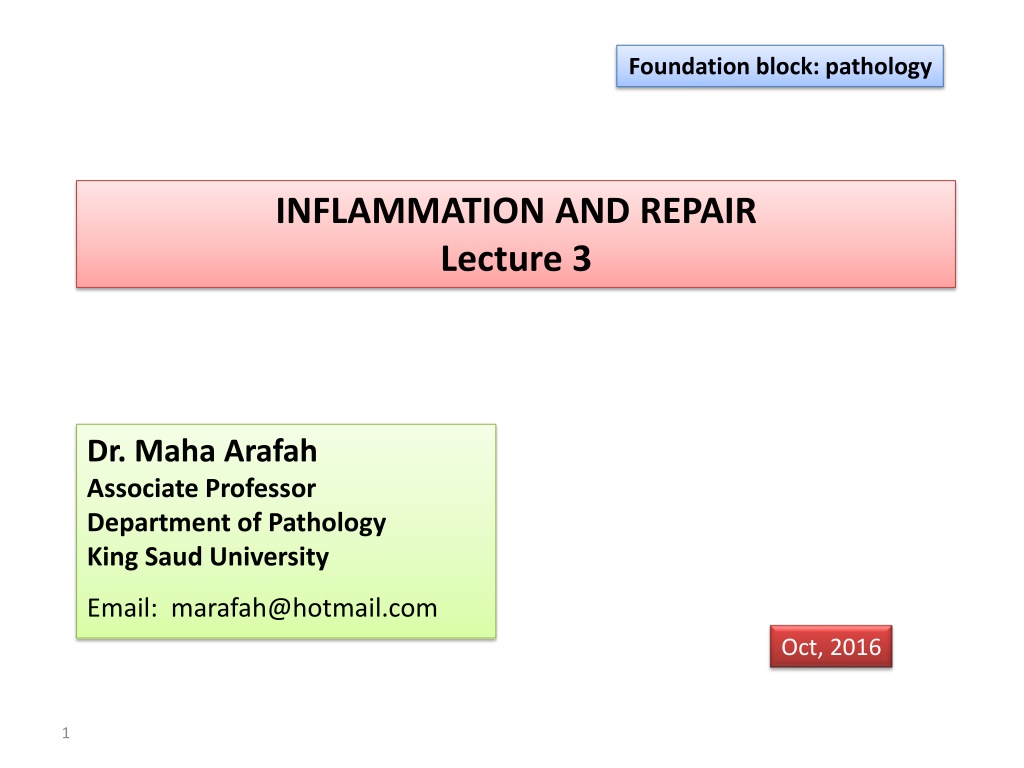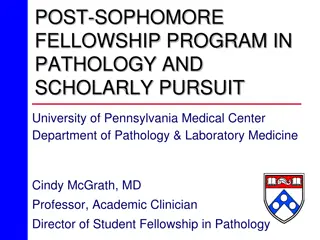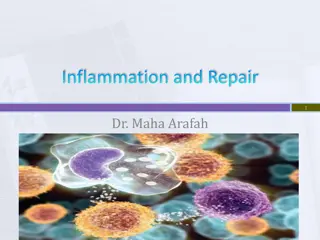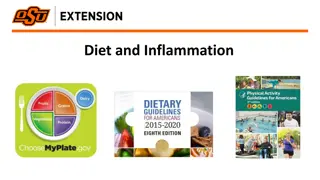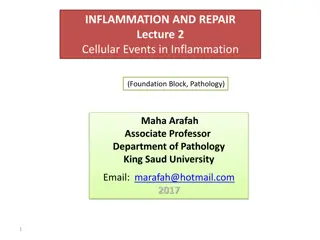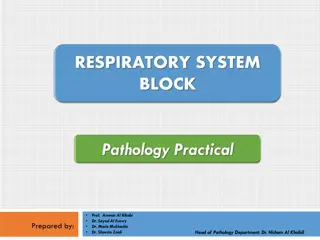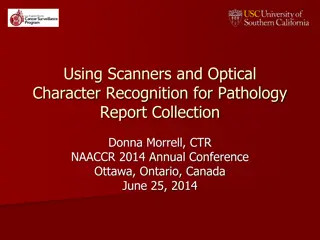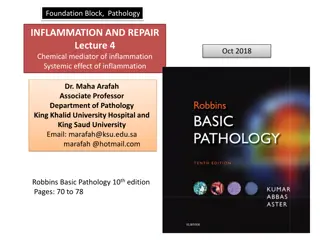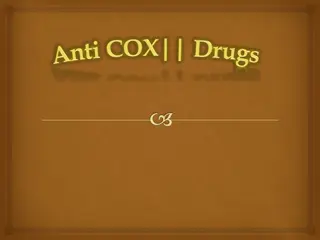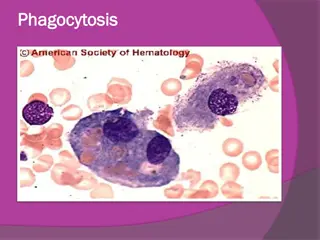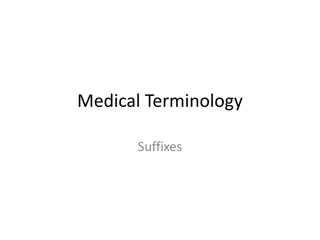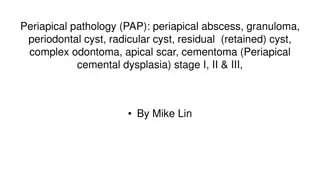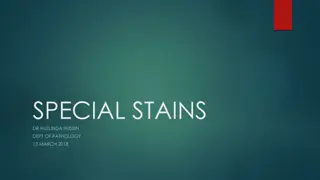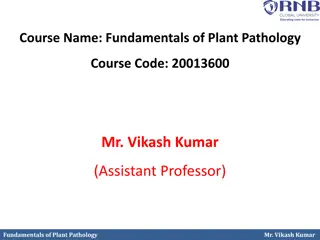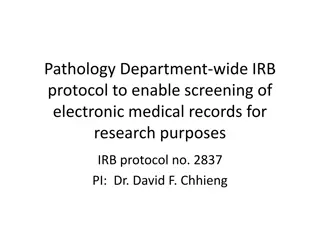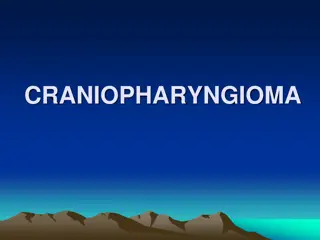Understanding the Outcomes and Patterns of Inflammation in Pathology
The lecture by Dr. Maha Arafah delves into the outcomes and patterns of acute inflammation, discussing outcomes like complete resolution, fibrosis, chronic inflammation progression, and abscess formation. It also covers chemical mediators, morphologic patterns, and events in inflammation resolution, guiding students on recognizing different patterns of inflammation and understanding the role of chemical mediators in the process.
Download Presentation

Please find below an Image/Link to download the presentation.
The content on the website is provided AS IS for your information and personal use only. It may not be sold, licensed, or shared on other websites without obtaining consent from the author. Download presentation by click this link. If you encounter any issues during the download, it is possible that the publisher has removed the file from their server.
E N D
Presentation Transcript
Foundation block: pathology INFLAMMATION AND REPAIR Lecture 3 Dr. Maha Arafah Associate Professor Department of Pathology King Saud University Email: marafah@hotmail.com Oct, 2016 1
1. Outcomes of acute inflammation 2. Different patterns of inflammation 3.Chemical mediators
Objectives 1. List and describe the outcome of acute inflammation. 2. Recognize the different patterns of inflammation. 3. Chemical mediators of inflammation: I. Definition II. Know the general principles for chemical mediators. III. Know the cellular sources and major effects of the mediators. IV. List the most likely mediators of each of the steps of inflammation.
1. List and describe the outcome of acute inflammation. Outcomes of Acute Inflammation Acute inflammation may have one of the four outcomes: Complete resolution Healing by connective tissue replacement (fibrosis) Progression of the tissue response to chronic inflammation Abscess formation 4
1. List and describe the outcome of acute inflammation. 5
1. List and describe the outcome of acute inflammation. Events in the resolution of inflammation This involves neutralization, decay, or enzymatic degradation of the various chemical mediators; normalization of vascular permeability; and cessation of leukocyte emigration and apoptosis The necrotic debris, edema fluid, and inflammatory cells are cleared by phagocytes and lymphatic drainage 6
Objectives Upon completion of this lecture, the student should: 1. List and describe the outcome of acute inflammation. 2. 2. Recognize the different pattern of Recognize the different pattern of inflammation. inflammation. 3. Define the chemical mediators of inflammation. I. Definition II. Know the general principles for chemical mediators. III. Know the cellular sources and major effects of the mediators. IV. List the most likely mediators of each of the steps of inflammation.
2. Recognize the different patterns of inflammation. Morphologic Patterns of Acute Inflammation Several types of inflammation vary in their morphology and clinical correlates. Why? The severity of the reaction specific cause the particular tissue site involved 8
2. Recognize the different patterns of inflammation. Morphologic Patterns of Acute Inflammation SEROUS INFLAMMATION FIBRINOUS INFLAMMATION SUPPURATIVE OR PURULENT INFLAMMATION ULCERS 9
2. Recognize the different patterns of inflammation. SEROUS INFLAMMATION: marked by the outpouring of a thin fluid 10
2. Recognize the different patterns of inflammation. FIBRINOUS INFLAMMATION A fibrinous exudate is characteristic of inflammation in the lining of body cavities, such as the meninges, pericardium and pleura (larger molecules such as fibrinogen pass the vascular barrier) Fibrinous exudates may be removed by fibrinolysis, if not: it may stimulate the ingrowth of granulation tissue (organization) 11
2. Recognize the different patterns of inflammation. Catarrhal inflammation Inflammation affects mucosa-lined surfaces with the outpouring of watery mucus
2. Recognize the different patterns of inflammation. SUPPURATIVE OR PURULENT INFLAMMATION characterized by the production of large amounts of pus or purulent exudate consisting of neutrophils, necrotic cells, and edema fluid caused by pyogenic (pus-producing) bacteria 13
2. Recognize the different patterns of inflammation. Suppurative abscess. An enclosed collection of pus consisits of a mixture of neutrophils and necrotic debris.
2. Recognize the different patterns of inflammation. Morphologic Patterns of Acute Inflammation SUPPURATIVE OR PURULENT INFLAMMATION Abscesses : localized collections of purulent inflammatory tissue caused by suppuration buried in a tissue, an organ, or a confined space 15
2. Recognize the different patterns of inflammation. ULCERS An ulcer is a local defect of the surface of an organ or tissue that is produced by the sloughing (shedding) of inflammatory necrotic tissue Epithelial Defect Necrotic base Fibrinopurulent exudates Granulation tissue Fibrosis 16
2. Recognize the different patterns of inflammation. Fistula A tract between two surfaces.
2. Recognize the different patterns of inflammation. Cellulitis denotes a spreading acute inflammation through interstitial tissues.
Objectives Upon completion of this lecture, the student should: 1. List and describe the outcome of acute inflammation. 2. Recognize the different pattern of inflammation. 3. Chemical mediators of inflammation: I. Definition II. Know the general principles for chemical mediators. III. Know the cellular sources and major effects of the mediators. IV. List the most likely mediators of each of the steps of inflammation.
3. Chemical mediators of inflammation What are mediators? Chemical mediators of inflammation are substances produced during inflammation inducing a specific events in acute inflammation.
3. Chemical mediators of inflammation General principles for chemical mediators The production of active mediators is triggered by: 1. microbial products 2.host proteins, such as the proteins of the complement, kinin and coagulation systems ( these are themselves activated by microbes and damaged tissues)
General principles for chemical mediators Most mediators have the potential to cause harmful effects. - Therefore, there should be a mechanism to checks and balances their action. Mediator function is tightly regulated by: 1) decay (e.g. AA metabolites) 2) inactivated by enzymes (kininase inactivates bradykinin) 3) eliminated ( antioxidants scavenge toxic oxygen metabolites)
3. Chemical mediators of inflammation Source of Chemical mediators Cell-derived: 1. Synthesized as needed (prostaglandin) 2. Preformed, sequestered and released (mast cell histamine) Plasma-derived: 1. Complement 2. kinins 3. coagulation factors Many in pro-form requiring activation (enzymatic cleavage)
3. Chemical mediators of inflammation Chemical Mediators of Inflammation Cell-Derived Plasma-Protein-Derived Vasoactive Amines Eicosanoids PAF Cytokines Chemokines ROS NO Lysosomal Enzymes of Leukocytes Neuropeptides
3. Chemical mediators of inflammation Chemical Mediators of Inflammation Plasma-Protein- Derived Cell-Derived Complement Coagulation and Kinin Systems
3. Chemical mediators of inflammation Cell-Derived Mediators Producing cells: Tissue macrophages Mast cells Endothelial cells Leukocytes
3. Chemical mediators of inflammation Vasoactive Amines Histamine & Serotonin Among first mediators in acute inflammatory reactions Preformed mediators in secretory granules
3. Chemical mediators of inflammation Histamine Source: many cell types, esp. mast cells, circulating basophils, and platelets Stimuli of Release: Physical injury Immune reactions C3a and C5a fragments Leukocyte-derived histamine- releasing proteins Neuropeptides Cytokines (e.g. IL-1 and IL-8) Actions: ARTERIOLAR DILATION INCREASED VASCULAR PERMEABILITY (venular gaps) ENDOTHELIAL ACTIVATION 1. 2. 3. Inactivated by: Histaminase
3. Chemical mediators of inflammation Serotonin (5-HT) Source: Platelets Action: Similar to histamine Stimulus: Platelet aggregation
3. Chemical mediators of inflammation Source: Leukocytes Mast cells Endothelial cells Platelets
3. Chemical mediators of inflammation 5 lipoxigenase pathway Cyclo oxigenase pathway Ss Ss 12 lipoxigenase pathway
3. Chemical mediators of inflammation Chemical Mediators of Inflammation Cell-Derived Plasma-Protein-Derived Vasoactive Amines Eicosanoids PAF Cytokines Chemokines ROS NO Lysosomal Enzymes of Leukocytes
3. Chemical mediators of inflammation Chemical Mediators of Inflammation Cell-Derived Cytokines Polypeptides Actions: Involved in early immune and inflammatory reactions Some stimulate bone marrow precursors to produce more leukocytes Plasma-Protein-Derived Vasoactive Amines Eicosanoids PAF Cytokines Chemokines ROS NO Lysosomal Enzymes of Leukocytes Neuropeptides
3. Chemical mediators of inflammation Cytokine of Acute inflammation: Interleukin (IL-1) & TNF
3. Chemical mediators of inflammation Major roles of cytokines in acute inflammation
3. Chemical mediators of inflammation Cytokines of Interferon- (INF- ) & Interleukin ( IL-12) Chronic Inflammation: Activated lymphocytes and macrophages influence each other and also release inflammatory mediators that affect other cells.
3. Chemical mediators of inflammation Chemical Mediators of Inflammation Cell-Derived Plasma-Protein-Derived Chemokines Vasoactive Amines Small proteins They are chemoattractants for leukocytes Main functions: Leukocyte recruitment & activation in inflammation Normal anatomic organization of cells in lymphoid and other tissues Eicosanoids PAF Cytokines Chemokines ROS NO Lysosomal Enzymes of Leukocytes Neuropeptides
3. Chemical mediators of inflammation Chemical Mediators of Inflammation Cell-Derived Reactive Oxygen Species Synthesized via NADPH oxidase pathway Source: Neutrophils and Macrophages Stimuli of release: Microbes Immune complexes Cytokines Action: Microbicidial (cytotoxic) agent Plasma-Protein-Derived Vasoactive Amines Eicosanoids PAF Cytokines Chemokines ROS NO Lysosomal Enzymes of Leukocytes Neuropeptides
3. Chemical mediators of inflammation Chemical Mediators of Inflammation Cell-Derived Nitric Oxide ( NO) Short-lived Soluble free-radical gas Functions: Vasodilation Antagonism of platelet activation (adhesion, aggregation, & degranulation) Reduction of leukocyte recruitment Microbicidial (cytotoxic) agent (with or without ROS) in activated macrophages Plasma-Protein-Derived Vasoactive Amines Eicosanoids PAF Cytokines Chemokines ROS NO Lysosomal Enzymes of Leukocytes Neuropeptides
3. Chemical mediators of inflammation Chemical Mediators of Inflammation Cell-Derived Lysosomal Enzymes of Leukocytes Neutrophils & Monocytes Enzymes: Acid proteases Neutral proteases (e.g. elastase, collagenase, & cathepsin) Plasma-Protein-Derived Vasoactive Amines Eicosanoids PAF Cytokines Chemokines Their action is checked by: Serum antiproteases (e.g. 1-antitrypsin) ROS NO Lysosomal Enzymes of Leukocytes Neuropeptides
3. Chemical mediators of inflammation Chemical Mediators of Inflammation Cell-Derived Neuropeptides Small proteins Secreted by nerve fibers mainly in lung & GIT Initiate inflammatory response e.g. Substance P : Transmits pain signals Regulates vessel tone Modulates vascular permeability Plasma-Protein-Derived Vasoactive Amines Eicosanoids PAF Cytokines Chemokines ROS NO Lysosomal Enzymes of Leukocytes Neuropeptides
3. Chemical mediators of inflammation Chemical Mediators of Inflammation Plasma-Protein- Derived Cell-Derived Complement Coagulation and Kinin Systems
3. Chemical mediators of inflammation PLASMA PROTEASES A variety of phenomena in the inflammatory response are mediated by plasma proteins that belong to three interrelated systems 1. Kinin 2. the complement 3. clotting systems
3. Chemical mediators of inflammation Kinin & clotting systems enhanced leukocyte adhesion & activation increases vascular permeability, pain increases vascular permeability, Chemotaxis
3. Chemical mediators of inflammation Complement System
3. Chemical mediators of inflammation Complement protein C3a & C5a Increase vascular permeability ( anaphylatoxins) C5a Chemotaxis C3b Opsonization C5-9 membrane attack complex
3. Chemical mediators of inflammation Prostaglandins Histamine Nitric oxide Vasoactive amines Bradykinin Leukotrienes C4, D4, E4 PAF Substance P C5a Leukotriene B4 Chemokines IL-1, TNF Bacterial products IL-1, TNF Prostaglandins Vasodilation Role of Mediators in Different Reactions of Inflammation Increased vascular permeability Chemotaxis, leukocyte recruitment and activation Fever Pain Prostaglandins Bradykinin Tissue damage Neutrophil and macrophage lysosomal enzymes Oxygen metabolites Nitric oxide
Mediators Source Principal Actions The Actions of the Principal Mediators : Cell-Derived Mast cells, basophils, platelets Platelets Serotonin Histamine Vasodilation, increased vascular permeability, endothelial activation Vasodilatation, increased vascular permeability. Vasodilatation, pain, fever. Prostaglandins Mast cells, leukocytes Leukotrienes Mast cells, leukocytes Increased vascular permeability, chemotaxis, leukocyte adhesion and activation. Vasodilatation, increased vascular permeability, leukocyte adhesion, chemotaxis, degranulation, oxidative burst Killing of microbes, tissue damage Platelet- activating factor Leukocytes, endothelial cells Reactive oxygen species Nitric oxide Leukocytes Endothelium, macrophages Vascular smooth muscle relaxation; killing of microbes Cytokines (e.g. TNF, IL-) Macrophages, lymphocytes Endothelial cells, mast cells Local endothelial activation (expres-sion of adhesion molecules), systemic acute- phase response in severe infections, septic shock
